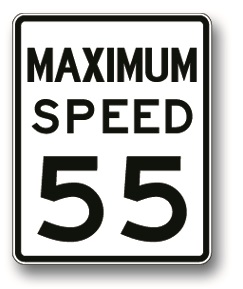
We see speed limit signs everywhere, whether we are driving through the countryside or along city streets. The setting of speed limits begins on a national level, with general guidelines for maximum speeds. Then, there are the state-level speed limits. These are the limits generally used on interstate highways and other limited access roads. Beyond the statewide level, there are a number of factors involved in the setting of speed zones. Additionally, there are federal laws concerning private properties with public use, and traffic signs—including the familiar speed limit sign—that change according to those laws.
Setting speed limits. According to the United States Department of Transportation (DOT) Federal Highway Administration (FHWA), traffic engineers consider many factors before setting a speed limit:
- a vehicle’s mechanical condition and characteristics
- driving ability/capabilities
- traffic volume: vehicles, pedestrians, and bicycles
- weather and visibility
- roadway design elements
- pavement conditions
- crash frequency and severity
With all factors considered, engineers select an appropriate methodology to set the speed limit. The DOT FHWA describes the four primary methods as follows:
- Engineering Approach―A two-step process where a base speed limit is set according to the 85th percentile speed, the design speed for the road, or other criterion. This base speed limit is adjusted according to traffic and infrastructure conditions such as pedestrian use, median presence, etc. Within the engineering approach there are two approaches; 1) Operating Speed Method and 2) Road Risk Method.
- Expert System Approach―Speed limits are set by a computer program that uses knowledge and inference procedures that simulate the judgment and behavior of speed limit experts. Typically, this system contains a knowledge base containing accumulated knowledge and experience (knowledge base), and a set of rules for applying the knowledge to each particular situation (the inference procedure).
- Optimization―Setting speed limits to minimize the total societal costs of transport. Travel time, vehicle operating costs, road crashes, traffic noise, and air pollution are considered in the determination of optimal speed limits.
- Injury Minimization or Safe System Approach‚ÄïSpeed limits are set according to the crash types that are likely to occur, the impact forces that result, and the human body’s tolerance to withstand these forces.
Be safe and follow the speed limit. The next time you see a speed limit sign remember, setting a speed limit is a complicated process. Speed limits are set by a number of different, proven methods in an attempt to keep you—the driver—and any surrounding pedestrians, safe. By following the speed limit, you help ensure the roads are as safe as possible for everyone who enjoys them.
To learn more about the methods and practices for setting the speed limit, please visit the DOT FHWA website.